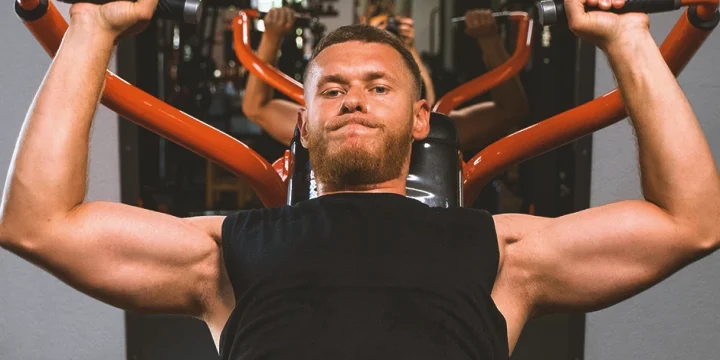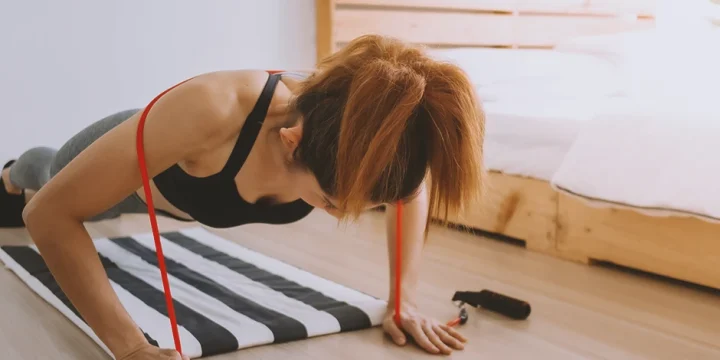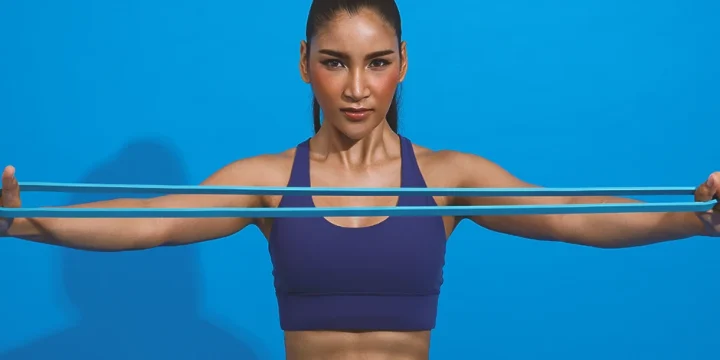Resistance training is a key component in sculpting and fortifying your upper body, and the good news is that you don't have to rely solely on weights or gym machines.
Resistance bands are a versatile and potent tool, perfectly capable of targeting your chest, back, shoulders, and arms with remarkable efficacy.
As an experienced fitness trainer, I've integrated resistance bands into my clients' workouts with impressive results.
In this article, we'll delve into the power of upper-body resistance band supersets. We'll cover their effectiveness, provide a blueprint for structuring these workouts, and offer a variety of exercises suited for different fitness levels.
Quick Summary
- Upper-body exercises performed with resistance bands are a practical, accessible, and challenging option that closely mimics free weights or machines.
- Strength training supersets usually work opposing muscle groups, maximizing workout efficiency.
- According to a study in PubMed, adding supersets into your workout using resistance bands instead of dumbbells can offer numerous benefits, including increased calorie-burning efficiency and growth hormone levels due to short rest intervals between sets.
- We recommend performing an upper-body resistance band workout at home a couple of times a week to improve strength, balance, and cardiovascular health.
Best Upper-body Supersets With Resistance Bands

Before we look at examples of effective resistance band supersets that will work out the entire upper body, let’s be clear on what supersets are.
What Are Supersets?
Supersets combine two back-to-back exercises without resting in between that usually target opposing muscle groups.
You can superset the same muscle group; both approaches are an effective way to challenge your muscles and maximize the efficiency of each workout.
“With supersets, you perform the first set of the second exercise right after completing the first set of the first exercise, before doing the second set of the first exercise”
- Tyler Read, Certified Personal Trainer
You can gain muscle and strength in your upper body with the following challenging resistance band workouts.
1. Chest/Back Supersets
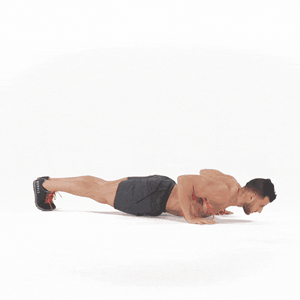
The following exercises are an effective way to primarily target the chest and back muscles during your resistance band workout.
Superset 1:
- Push-ups: 5 sets of 12, 10, 8, 6, and 5 reps
- Wide-grip pull-ups: 5 sets of 10 reps
Push-ups are a traditional chest exercise that uses your body weight to target the pecs, triceps, and core.
The extra resistance from bands can add significant challenge and benefit from push-ups:
- Wrap band around the back, just below the armpits.
- Ensure an optimal fit by looping once around each hand to tighten.
- Perform a push-up.
Wide-grip pull-ups using resistance bands can effectively workout the back, shoulders, and core muscles.
With an anchored resistance band:
- Hold the handles at the side of your chest.
- Lean back, slowly lowering your body while keeping your back flat.
- Pause when your arms are in the fully extended position.
- Pull your body back up toward your chest.
Superset 2:
- Incline chest press: 5 sets of 12, 10, 8, 8, and 8 reps
- Standing lat rows: 5 sets x 10 reps
The incline chest press is a great way to build your upper chest. With an anchored resistance band at the hip level:
- Step into the loop to engage your chest and feel a controlled backward pull.
- Bring your shoulder blades together and down.
- Press both hands forward at 45 degrees until fully extended.
- Bring hands together in the fully extended position.
- Slowly move back against the band’s resistance before repeating.
Standing lat rows will primarily workout the upper back and shoulder muscles.
Attach a band to an anchor point at chest level:
- Begin by holding the band with both hands using an underarm grip and hands shoulder-width apart.
- Slowly move backward until you feel tension on the resistance band.
- With knees slightly bent, pull the band toward you until it touches your stomach.
- Keep your core engaged and your neck and head relaxed.
Slowly release tension until you are back to the start, and repeat.
2. Bicep/Tricep Superset
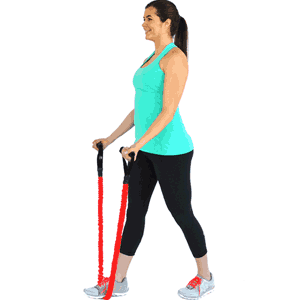
The following is a push-pull superset workout that works the biceps and triceps:
- Bicep curls: 5 sets of 8 reps
- Overhead triceps extension: 5 sets of 10 reps
Perform a biceps curl in your resistance band workout by:
- Standing with both feet on the band, hold the handles next to your side with your palms facing forward.
- Slowly bring your hands up to your shoulders while squeezing your biceps and keeping your elbows right next to your sides.
- Slowly bring arms back down to starting position and repeat.
Triceps extensions isolate the triceps muscle and pair nicely with the biceps curl to create a superset.
Here are the steps:
- Stand with your right or left foot slightly in front of the other.
- Place the middle of the band under the back foot.
- Bring the handles together straight up above your head.
- Slowly lower handles behind the back of your head, bringing elbows to 90 degrees while keeping them close to the side of your head.
- Slowly bring hands back overhead and repeat.
Related: Best Resistance Band Tricep Exercises: An Ultimate Guide
3. Shoulders Superset
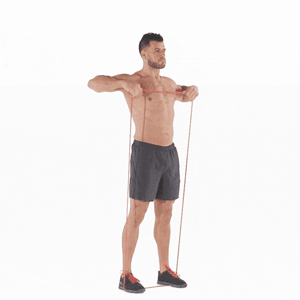
The following is an example of a shoulders superset:
- Lateral raises: 4 sets of 12, 10, 8, and 8 reps
- Upright rows: 4 sets of 10 reps
Lateral raises target the lateral deltoid muscle. To perform this exercise with a resistance band:
- Stand with feet hip-width apart with the resistance band under both feet.
- With an overhand grip, hold the handles by your side.
- Pull up until your hands are at shoulder height.
- Slowly lower down and repeat.
The upright row will primarily target the shoulders and upper back:
- Stand on a resistance band, holding handles with the palms resting on your thighs.
- Keeping your back straight and your elbows higher than your forearm, lift the band toward your chin.
- Briefly pause, then inhale as you lower the band back to where you began.
- Repeat.
Also Read: Top 10 Resistance Band Shoulder Exercises
Benefits Of This Approach
According to a study in PubMed, adding supersets into your workout using resistance bands instead of dumbbells can offer numerous benefits, including increased calorie-burning efficiency and growth hormone levels due to short rest intervals between sets [1].
This increase leads to a higher release of fat cells as energy, improving fat loss and decreasing exercise time.
Read More: Best Full Body Power Band Workout
Rehabilitation and Injury Prevention with Resistance Bands
Over the years, I’ve learned that resistance bands are not just for fitness enthusiasts; they are a cornerstone in the world of rehabilitation and injury prevention.
Their unique ability to provide variable resistance makes them ideal for gently strengthening muscles without the risk of overloading joints.
They help with:
- Gradual muscle strengthening: For individuals recovering from upper body injuries, resistance bands offer a safe way to gradually increase muscle strength. Bands allow for a natural progression of movement, reducing the risk of re-injury, while offering the same muscle gains as traditional weights [2]
- Joint-friendly workouts: The elasticity of bands provides a joint-friendly workout option. This is particularly beneficial for those with arthritis or chronic joint pain, as it allows for strengthening without exacerbating joint stress.
- Enhanced proprioception: I’ve found that using resistance bands can improve proprioception — the body's ability to perceive its own position in space. This is crucial in rehabilitation, as it helps in retraining the body to move correctly and efficiently.
FAQs
What Are the Cons of Supersets?
One significant con of supersets is that it decreases your ability to lift heavier loads because of fatigue. Fatigue will set in sooner during supersets, especially during the second movement.
Are Resistance Bands Good for Upper Body Workouts?
Resistance bands are a good way to give the entire upper body an intense workout. Always have the band controlled; if you don’t, the resistance may be too high for you, increasing injury risk.
References:
- https://pubmed.ncbi.nlm.nih.gov/33927111/
- https://www.ncbi.nlm.nih.gov/pmc/articles/PMC6383082/
About The Author
You May Also Like

